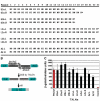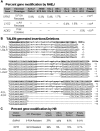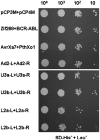Modularly assembled designer TAL effector nucleases for targeted gene knockout and gene replacement in eukaryotes
- PMID: 21459844
- PMCID: PMC3152341
- DOI: 10.1093/nar/gkr188
Modularly assembled designer TAL effector nucleases for targeted gene knockout and gene replacement in eukaryotes
Abstract
Recent studies indicate that the DNA recognition domain of transcription activator-like (TAL) effectors can be combined with the nuclease domain of FokI restriction enzyme to produce TAL effector nucleases (TALENs) that, in pairs, bind adjacent DNA target sites and produce double-strand breaks between the target sequences, stimulating non-homologous end-joining and homologous recombination. Here, we exploit the four prevalent TAL repeats and their DNA recognition cipher to develop a 'modular assembly' method for rapid production of designer TALENs (dTALENs) that recognize unique DNA sequence up to 23 bases in any gene. We have used this approach to engineer 10 dTALENs to target specific loci in native yeast chromosomal genes. All dTALENs produced high rates of site-specific gene disruptions and created strains with expected mutant phenotypes. Moreover, dTALENs stimulated high rates (up to 34%) of gene replacement by homologous recombination. Finally, dTALENs caused no detectable cytotoxicity and minimal levels of undesired genetic mutations in the treated yeast strains. These studies expand the realm of verified TALEN activity from cultured human cells to an intact eukaryotic organism and suggest that low-cost, highly dependable dTALENs can assume a significant role for gene modifications of value in human and animal health, agriculture and industry.
Figures





Similar articles
-
Efficient design and assembly of custom TALEN and other TAL effector-based constructs for DNA targeting.Nucleic Acids Res. 2011 Jul;39(12):e82. doi: 10.1093/nar/gkr218. Epub 2011 Apr 14. Nucleic Acids Res. 2011. PMID: 21493687 Free PMC article.
-
TAL effector nuclease (TALEN) engineering.Methods Mol Biol. 2013;978:63-72. doi: 10.1007/978-1-62703-293-3_5. Methods Mol Biol. 2013. PMID: 23423889
-
TAL nucleases (TALNs): hybrid proteins composed of TAL effectors and FokI DNA-cleavage domain.Nucleic Acids Res. 2011 Jan;39(1):359-72. doi: 10.1093/nar/gkq704. Epub 2010 Aug 10. Nucleic Acids Res. 2011. PMID: 20699274 Free PMC article.
-
Origins of Programmable Nucleases for Genome Engineering.J Mol Biol. 2016 Feb 27;428(5 Pt B):963-89. doi: 10.1016/j.jmb.2015.10.014. Epub 2015 Oct 23. J Mol Biol. 2016. PMID: 26506267 Free PMC article. Review.
-
TALEN-mediated genome engineering to generate targeted mice.Chromosome Res. 2015 Feb;23(1):43-55. doi: 10.1007/s10577-014-9457-1. Chromosome Res. 2015. PMID: 25596827 Review.
Cited by
-
Knockout of the adp gene related with colonization in Bacillus nematocida B16 using customized transcription activator-like effectors nucleases.Microb Biotechnol. 2015 Jul;8(4):681-92. doi: 10.1111/1751-7915.12282. Epub 2015 Apr 24. Microb Biotechnol. 2015. PMID: 25912819 Free PMC article.
-
Hooked! Modeling human disease in zebrafish.J Clin Invest. 2012 Jul;122(7):2337-43. doi: 10.1172/JCI60434. Epub 2012 Jul 2. J Clin Invest. 2012. PMID: 22751109 Free PMC article.
-
Genome-scale engineering for systems and synthetic biology.Mol Syst Biol. 2013;9:641. doi: 10.1038/msb.2012.66. Mol Syst Biol. 2013. PMID: 23340847 Free PMC article. Review.
-
The million mutation project: a new approach to genetics in Caenorhabditis elegans.Genome Res. 2013 Oct;23(10):1749-62. doi: 10.1101/gr.157651.113. Epub 2013 Jun 25. Genome Res. 2013. PMID: 23800452 Free PMC article.
-
Heritable gene targeting in zebrafish using customized TALENs.Nat Biotechnol. 2011 Aug 5;29(8):699-700. doi: 10.1038/nbt.1939. Nat Biotechnol. 2011. PMID: 21822242 No abstract available.
References
-
- Cathomen T, Joung JK. Zinc-finger nucleases: The next generation emerges. Mol. Ther. 2008;16:1200–1207. - PubMed
-
- Urnov FD, Rebar EJ, Holmes MC, Zhang HS, Gregory PD. Genome editing with engineered zinc finger nucleases. Nat. Rev. Genet. 2010;11:636–646. - PubMed
-
- Jasin M. Genetic manipulation of genomes with rare-cutting endonucleases. Trends Genet. 1996;12:224–228. - PubMed
Publication types
MeSH terms
Substances
LinkOut - more resources
Full Text Sources
Other Literature Sources
Molecular Biology Databases
Miscellaneous

